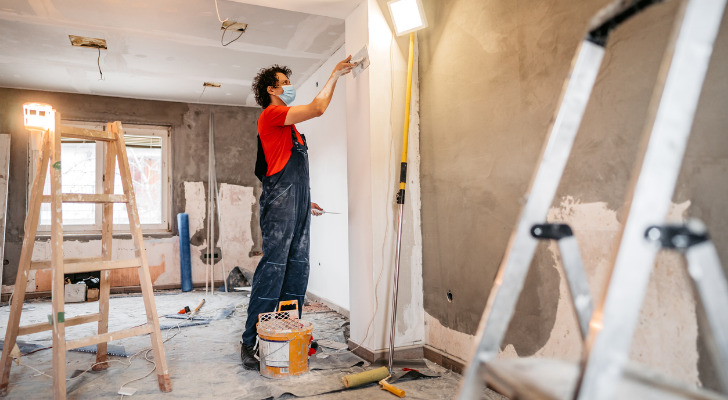Investing in home improvements can lead to tax savings, but only if the upgrades qualify as capital improvements. These expenses cannot be deducted immediately. Instead, they’re factored in when you sell your home. For homeowners whose profits fall below the capital gains exemption threshold, this deduction may not be significant. However, for those who make substantial upgrades and sell their home for a profit exceeding $250,000 ($500,000 for joint filers) it can result in significant tax savings.
A financial advisor can help you figure out how to make the most of capital improvements and other real estate investment strategies.
Capital Improvement Deduction Basics
Funds spent to improve a home can be deducted from the capital gains when a home is sold, potentially reducing capital gains taxes. The deductible expenses have to be for improvements that last more than a year. The Internal Revenue Service defines the term like this: “Improvements add to the value of your home, prolong its useful life, or adapt it to new uses.” 1
Minor repairs, on the other hand, are not deductible. Here’s the IRS definition of a non-deductible expense: “Any costs of repairs or maintenance that are necessary to keep your home in good condition but don’t add to its value or prolong its life.”
Examples of Capital Improvements
Capital improvements include:
- Additions, such as a new bedroom, bathroom, porch or patio
- Remodeling existing space such as updating a kitchen or finishing a basement
- Replacing siding, roof or windows
- Adding insulation to attic, walls, floors or ducts
- Replacing or adding air conditioning, furnace, lawn sprinkler or security system
- Adding a septic system or replacing a water heater
- Adding or replacing flooring such as wall-to-wall carpeting
- Building a swimming pool, fence or driveway or adding landscaping
Examples of non-deductible repairs include:
- Painting the interior or exterior
- Replacing broken hardware
- Filling holes and cracks
- Fixing leaks
Exceptions and Other Considerations
Several exceptions exist. For instance, costs of repair-type work done during a capital improvement project can be deducted. That is, the expense of replacing a broken window, which would ordinarily be a non-deductible repair, could be deducted if done while replacing windows as part of a deductible capital improvement project.
Capital improvement projects are not deductible in the year you spend the money. For example, replacing wall-to-wall carpeting is not deductible if the homeowner installs new carpet or other flooring just before selling the property.
However, repair expenses can be deducted when applied to business properties, such as a home office or rental unit. These deductions are treated differently. Repair costs can be deducted in the same year they are incurred, while capital improvement expenses are depreciated over multiple years instead of being deducted only when the property is sold.
How Capital Improvement Deductions Work
When selling a home, the seller may be liable for capital gains taxes on the profit made from the sale, calculated as the difference between the sale price and the home’s cost basis. Capital improvements can help lower this tax burden by increasing the cost basis. The initial cost basis includes the home’s purchase price, along with closing costs and other related expenses. Any capital improvements made after the purchase are added to this cost basis, reducing the taxable gain.
For example, suppose a homeowner buys a property for $200,000 and sells it 20 years later for $500,000. Without adjustments, the capital gain would be $300,000. The difference between the original $200,000 cost basis and the $500,000 sale price.
However, during ownership, the homeowner invests $75,000 in capital improvements, such as a new roof, a swimming pool, and a kitchen renovation. Adding this $75,000 to the original cost basis increases it to $275,000. As a result, the taxable gain is reduced to $225,000 ($500,000 – $275,000).
Capital gains tax rates range from 0% to 20%, depending on the seller’s income and the length of ownership. If the homeowner falls under a 15% capital gains tax rate, the $75,000 in capital improvements could reduce their tax liability by $11,250 ($75,000 × 15%).
How to Track and Document Capital Improvements

Accurate recordkeeping is essential when claiming capital improvement deductions. The IRS requires proof that each project meets the definition of an improvement and that the related costs were actually paid. Homeowners should keep detailed records, including dated receipts, contractor invoices, canceled checks, building permits, and photos that show before-and-after conditions. Documentation should clearly describe the work performed and list materials used, since vague or incomplete entries may not qualify during an audit or property sale review.
It’s important to maintain these records for as long as you own the property and for at least three years after filing the tax return for the year of sale. Many homeowners misplace older receipts over time, losing the ability to adjust their cost basis accurately when selling. Keeping digital copies can make long-term record retention easier and protect against loss or damage to paper documents.
If multiple improvements occur over many years, creating a running ledger can help track cumulative costs. The ledger should include the date, description, vendor, and total expense for each project. When the property is sold, this list will simplify calculating the adjusted cost basis and provide support for any capital gains reduction.
For homeowners who have both repair and improvement costs in a single project, records should clearly separate these categories. For instance, if a kitchen renovation included fixing a leak and replacing cabinets, the leak repair is not deductible while the cabinetry is. Distinguishing between the two helps prevent errors in tax filings and supports accurate reporting in the event of IRS review.
Capital Improvement Deduction Limitations
Capital improvement deductions aren’t useful for every homeowner. Federal law excludes many gains on sales of primary residences from capital gains taxes. This home sale exclusion is capped at $500,000 for couples and $250,000 for individuals.
In the above example, the gain before capital improvement deductions would have been $300,000, so the taxpayer may have owed taxes on part of the gain before deductions. However, homeowners who realize a gain on sale of their homes that is below the exclusion cap don’t owe taxes on the gain.
Another limitation is that home sellers can’t deduct a capital improvement that has received a tax credit. For example, if a homeowner gets a tax credit for adding solar panels, the cost of the panels can’t be deducted as a capital improvement.
Taxpayers also may need to document the cost of the repairs using receipts and invoices, so it’s best to keep accurate and completed records. Repair costs don’t have to be documented when claimed, but the IRS may later ask to see proof.
Bottom Line

Costs of capital improvements can be deducted from taxes on gains when selling a home. Only certain improvements can be deducted and many repairs are not deductible. Home sellers whose gains are less than the exclusion from capital gains won’t benefit from deducting capital improvement costs. A financial advisor can help you navigate the tax deductions at your disposal during a real estate sale.
Capital Improvement Tips
- A financial advisor can help you evaluate the dollars and cents of decisions about buying, improving and selling a home. Finding a qualified financial advisor doesn’t have to be hard. SmartAsset’s free tool matches you with financial advisors who serve your area, and you can interview your advisor matches at no cost to decide which one is right for you. If you’re ready to find an advisor who can help you achieve your financial goals, get started now.
- When a home sustains damage from natural disaster or fire, any expense required to return the home to its previous condition is a deductible capital improvement. That includes projects that would otherwise be non-deductible repairs.
Photo credit: ©iStock.com/metamorworks, ©iStock.com/jeffbergen, ©iStock.com/smshoot
Article Sources
All articles are reviewed and updated by SmartAsset’s fact-checkers for accuracy. Visit our Editorial Policy for more details on our overall journalistic standards.
- Internal Revenue Service. https://www.irs.gov/pub/irs-pdf/p523.pdf. Accessed 21 Nov. 2025.
